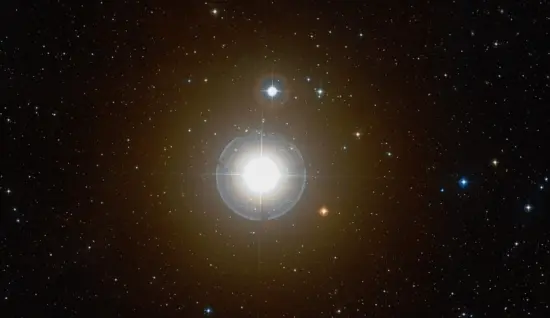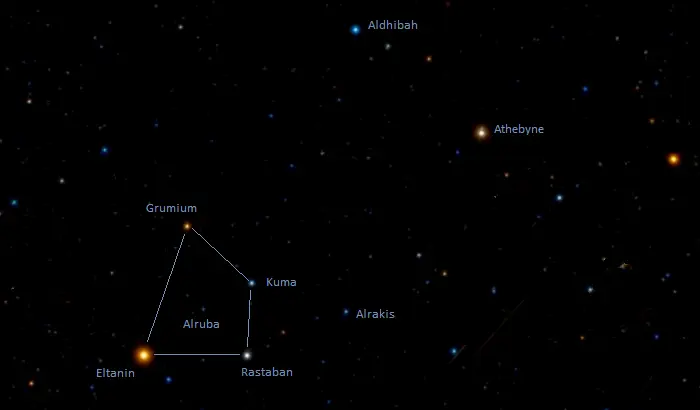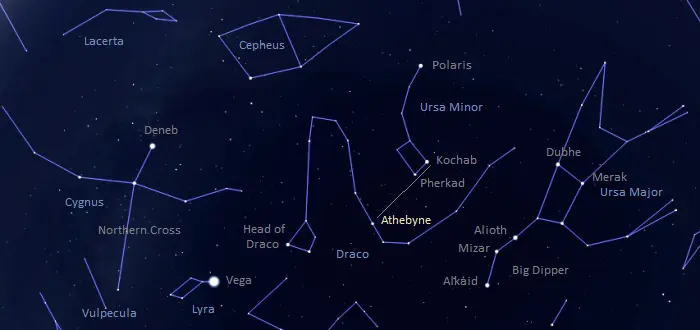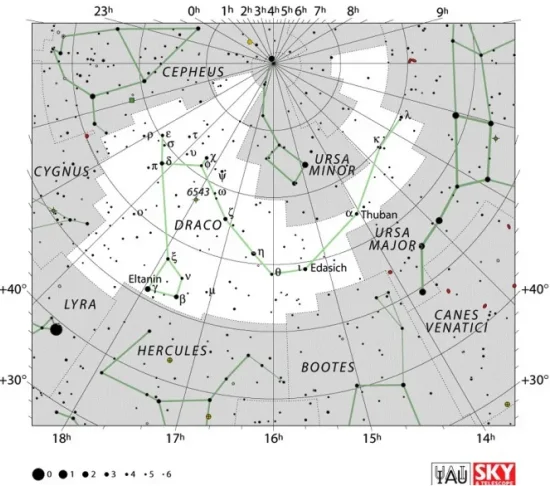Athebyne, Eta Draconis (η Dra) is the primary component in a binary star system located in the northern constellation Draco. With an apparent magnitude of 2.73, it is the second brightest star in Draco, after Eltanin. The star is a G-type yellow giant located 92.1 light-years away.
Star system
Eta Draconis is a binary system consisting of Athebyne (Eta Draconis A) and the dwarf star Eta Draconis B.
Athebyne, the primary component, is a yellow giant star of the spectral type G8 III. It has a mass 2.55 times that of the Sun and 11 times the radius of the Sun. With a surface temperature of 5,055 K, it shines with 60 solar luminosities. The star’s age is about 550 million years.
Even though it is a young star, Eta Draconis A has already burned through its supply of hydrogen fuel and evolved away from the main sequence.

Athebyne (Eta Draconis), image: Wikisky
Eta Draconis B is separated by only 5.1 arcseconds from the main star. It is a K-type main sequence star (an orange dwarf) with an apparent visual magnitude of 8.8.
The two components of the Eta Draconis system lie at a physical distance of at least 140 astronomical units (Earth-Sun distances) from each other and take at least a thousand years to complete an orbit.
Facts
The radiant of the Eta Draconids, a meteor shower discovered in 2011, appears near Athebyne. The meteor shower peaked in February 2011, when six meteors with a common radiant were observed in a short period. The meteor shower is not an annual occurrence like the Draconids, which peak in October.
In Arabic astronomy, Eta and Zeta Draconis (Athebyne and Aldhibah) represented two wolves (or two hyenas) stalking the camel’s foal, which was protected by the Mother Camels. The Mother Camels asterism was formed by the same stars that outline the head of Draco (Eltanin, Rastaban, Grumium, and Kuma) and the foal was represented by Alruba (HD 161693), a faint star at the centre of the Mother Camels asterism. The star Mu Draconis (Alrakis) represented another camel running to join its companions. The name Alruba comes from the Arabic word for “the foal,” and Aldhibah is derived from the Arabic al-dhiʼb, meaning “the wolf” or “the hyena.”

The Two Wolves and the Mother Camels, image: Wikisky
Name
The name Athebyne (pronunciation: /ˈæθɪbaɪn/) comes from the Arabic al-dhiʼbayn, meaning “the (two) wolves.” It was historically also spelled Aldibain.
The name was approved by the International Astronomical Union’s (IAU) Working Group on Star Names (WGSN) on September 5, 2017. It formally applies only to the component Eta Draconis A but has traditionally been used for the double star system.
In Chinese astronomy, Eta Draconis was known as 紫微左垣三 (Zǐ Wēi Zuǒ Yuán sān), the Third Star of Left Wall of Purple Forbidden Enclosure. It represented the Second Premier (Shàozǎi, 少宰). The Left Wall asterism was formed by Athebyne with Edasich (ι Draconis), Theta Draconis, Aldhibah (ζ Draconis), Upsilon Draconis, 73 Draconis, Pi Draconis, Errai (γ Cephei), and 23 Cassiopeiae. The larger Purple Forbidden Enclosure (紫微垣 Zǐ Wēi Yuán) represented the imperial palace.
Location
Athebyne is easy to find because it is a relatively bright star and lies between two recognizable asterisms, the Little Dipper and the Head of Draco. These star patterns are not very conspicuous but can be found using the brighter stars of the Big Dipper in the constellation Ursa Major and the Northern Cross in Cygnus.
Athebyne lies on the imaginary line extended from the outer stars of the Little Dipper’s bowl. These stars, Kochab (Beta Ursae Minoris) and Pherkad (Gamma Ursae Minoris), are known as the Guardians of the Pole because they always circle around Polaris (Alpha Ursae Minoris), the North Star.

The location of Athebyne (Eta Draconis), image: Stellarium
While Polaris, Kochab and Pherkad are quite bright, the middle four stars of the Little Dipper are fainter and not as easy to make out. However, to locate Athebyne, one only needs Kochab and Pherkad, not the entire Little Dipper. The Guardians of the Pole are roughly parallel to Mizar and Alioth in the brighter and larger Big Dipper.
Athebyne is part of a curving line of stars that form the body and tail of Draco. The line begins with Grumium (Xi Draconis) in the Dragon’s head and continues with Altais (Delta Draconis), Epsilon Draconis, Chi Draconis, Aldhibah (Zeta Draconis), Athebyne (Eta Draconis), Kuma (Nu Draconis), Edasich (Iota Draconis), Thuban (Alpha Draconis), Kappa Draconis, and Lambda Draconis between the Big and Little Dippers.
Athebyne can be used to find several galaxies in Draco. The elliptical or lenticular galaxy NGC 6223 has a visual magnitude of 11.7 and is visible in 10-inch and larger telescopes, but it requires exceptionally good conditions.
The Draco Trio (or the Draco Group), consisting of the spiral galaxies NGC 5981 and NGC 5985 and the elliptical galaxy NGC 5982, appears near the orange giant Edasich (Iota Dra), in the direction of Athebyne (Eta Dra). NGC 5982 is the central galaxy in the NGC 5982 Group. It lies 123 million light-years from the solar system.
The spiral galaxy NGC 6015 appears near the A-type star HD 141653 (mag.5.19) and can be seen in telescopes with an aperture of at least 6 inches.
Athebyne and HD 141653 can be used to find a telescopic asterism known as the Ring of the Nibelung or Ferrero 27. The asterism appears 1.3 degrees east of HD 141653 and only 47 arcminutes east-northeast of the galaxy NGC 6015.
Constellation
Athebyne is located in the circumpolar constellation Draco. The celestial Dragon is visible to observers in the northern hemisphere throughout the year but stays very low above the northern horizon – if it makes an appearance at all – for observers south of the equator.
Draco is the eighth largest constellation in the sky. It stretches across an area of 1,083 square degrees of the northern sky around the Little Dipper. Even though it is large, Draco does not really stand out in the night sky. Eltanin (Gamma Draconis), its brightest star, shines at magnitude 2.24.

Draco constellation map by IAU and Sky&Telescope magazine
Draco is one of the 48 Greek constellations catalogued by the Greek astronomer Ptolemy in the 2nd century CE. In Greek mythology, it is associated with the dragon Ladon from the legend of Heracles’ Twelve Labours. The dragon guarded the golden apples of the Hesperides and met its end at the hero’s hands. It was transformed into a constellation by Hera. The constellation Hercules is typically depicted with one foot on the Dragon’s head.
The constellation of Draco hosts many notable stars, among them several stars that occasionally serve as North Stars during the Earth’s axial precession cycle: the orange giant Edasich (Iota Draconis), the class A subgiant Thuban (Alpha Draconis), and the hot blue giant Kappa Draconis.
Other notable stars in Draco include the orange giant Eltanin (Gamma Draconis) and yellow supergiant or bright giant Rastaban (Beta Draconis), the stars that mark the Dragon’s eyes, the multiple star system Mu Draconis (Alrakis), the blue giant Aldhibah (Zeta Draconis), and the yellow giants Altais (Delta Draconis) and Omicron Draconis.
Famous deep sky objects in the constellation include the Spindle Galaxy (NGC 5866), the Splinter Galaxy (NGC 5907), the planetary nebula NGC 6543 (the Cat’s Eye Nebula), the massive galaxy cluster Abell 2218, the Tadpole Galaxy (Arp 188), and the Draco Dwarf, a spheroidal galaxy that is a satellite galaxy of the Milky Way. The Spindle Galaxy is believed to be the object that the French astronomer Charles Messier catalogued as the Messier object 102.
The best time of the year to see the stars and deep sky objects in Draco is during the month of July, when the constellation is high above the horizon in the evening. The entire constellation is visible north of the latitude 15° S.
The 10 brightest stars in Draco are Eltanin (γ Draconis, mag. 2.23), Athebyne (η Draconis, mag. 2.73), Rastaban (β Draconis, mag. 2.79), Altais (δ Draconis, mag. 3.07), Aldhibah (ζ Draconis, mag. 3.17), Edasich (ι Draconis, mag. 3.29), Chi Draconis (χ Draconis, mag. 3.57), Thuban (α Draconis, mag. 3.6452), Grumium (ξ Draconis, mag. 3.75), and Giausar (λ Draconis, mag. 3.85).
Athebyne – Eta Draconis
| Spectral class | G8 III or G8 IIIab |
| U-B colour index | +0.70 |
| B-V colour index | +0.91 |
| Apparent magnitude | 2.73 |
| Angular diameter | 3.72 ± 0.07 mas |
| Absolute magnitude | +0.58 |
| Distance | 92.1 ± 0.2 light-years (28.23 ± 0.07 parsecs) |
| Parallax | 35.7163 ± 0.2829 mas |
| Radial velocity | –14.3 ± 0.0003 km/s |
| Proper motion | RA: -16.394 ± 0.346 mas/yr |
| Dec.: +57.094 ± 0.570 mas/yr | |
| Mass | 2.55 M☉ |
| Luminosity | 60 L☉ |
| Radius | 11 R☉ |
| Temperature | 5,055 K |
| Metallicity | -0.04 dex |
| Age | 550 million years |
| Rotational velocity | 8 km/s |
| Surface gravity | 2.82 cgs |
| Constellation | Draco |
| Right ascension | 16h 23m 59.4863284790s |
| Declination | +61° 30′ 51.155139051″ |
| Names and designations | Athebyne, Eta Draconis, η Dra, 14 Draconis, HD 148387, HR 6132, HIP 80331, FK5 822, SAO 17074, BD+61 1591, AG+61 940, GC 22101, GCRV 9453, GJ 9561 A, GJ 624.1 A, PLX 3740, NSV 7713, GSC 04190-02568, JP11 2751, PPM 19869, CSV 102800, UBV 13920, IRAS 16232+6137, 2MASS J16235949+6130509, TYC 4190-2568-1, Gaia DR2 1625209684868172544, Gaia DR3 1625209684868707328, WDS 16240+6131, ADS 10058 A, CCDM J16239+6130A, IDS 16226+6144 A |